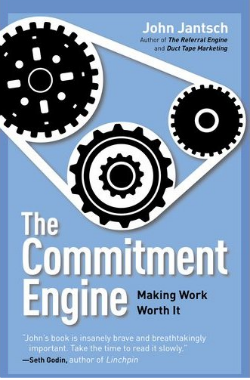 My friend of many years, John Jantsch is a marketing consultant, speaker and author known the world over for offering practical marketing advice to tens of thousands of small businesses. This week he’s launching a new book, The Commitment Engine – Making Work Worth It and I asked if he’d share a peek for our readers here at TopRank’s Online Marketing Blog.
My friend of many years, John Jantsch is a marketing consultant, speaker and author known the world over for offering practical marketing advice to tens of thousands of small businesses. This week he’s launching a new book, The Commitment Engine – Making Work Worth It and I asked if he’d share a peek for our readers here at TopRank’s Online Marketing Blog.
With growing popularity, more companies are becoming aware of the importance and impact of content marketing. But many are unsure how to create content that customers actually want and that can have an impact on the business bottom line. In this guest post, John Jantsch offers practical advice that any business, small or large, can implement today for less mechanical and more meaningful content creation.
The creation and distribution of content has become such a significant aspect of effective marketing and community building these days that it requires a high place in the strategy conversation in most every business.
The word content is confusing enough as it’s bantered around these days, but it’s also difficult for many business owners and marketers to come up with a big picture view of the role content plays in the process of building trust, being found and acquiring clients.
Strategically, the word content must mean more than a blog post or a blank sheet of paper each day. You must begin to think of your content as a total body of work that is being built to serve your business community over time.
You must understand and create content for the most important keyword phrases for your industry, the essential themes of education in your business, and your company’s core points of differentiation.
You must also think in terms of your content as a tool that moves prospects and customer from awareness to conversion and in this effort there are at least five types of content that you must address. Each type must be considered as part of your overall content strategy.
Trust Building Content
One of the first jobs of your content is to bridge the gap from awareness to trust building. Your SEO efforts actually marry with this type of content to make sure you are both found and found in abundance.
- How to content – specific advice or tips and tricks
- Reviews – customer reviews on sites like Yelp and Google+ Local
- Testimonials – endorsements from happy customers
- Articles – articles you’ve written or that mention your firm in outside publications
Educational Content
Once you create awareness and trust a prospect will be hungry to find out much more about your unique approach, your solution, your story and your organization.
- eBooks – not boring, dry technical stuff, your best writing tying a bigger topic together
- Newsletter – Weekly or monthly education that nurtures their interest
- Seminars – in person or online, these allow prospects to learn as well as engage
- FAQs – some folks just need the answers to their questions and this format serves well
- Survey data – results from surveys can be very compelling as a way to let prospects know you understand them
Community Contributed Content
Getting your customers involved in the production of content builds loyalty and community, creates proof of results and gives you another avenue for content creation.
- Automatic referrals and reviews – create ways to move happy customers to a referral and review process using form tools such as Wufoo
- Testimonials – automate this process by providing online audio and video tools such as AudioAcrobat or MailVu
- Video success stories – create events that bring customers together to tell their story and network
- Guest blog posts – allow your customers to tell their story with your product
Filtered Content
One of the primary jobs of marketers these days is to provide some insight to the stream of information that our customers face. Filtering and aggregating content produced by others is not only a great service; it’s a great differentiator.
- Custom RSS feeds – create customer or industry specific feeds to share
- Republish, Share, RT – point to and share great content that being produced
- Curate – use tools like Storify to collect and republish customer newsletters
Conversion Content
This last category is one that gets overlooked in the write for writing sake view of content. Ultimately, great content has the ability to call and convert prospects to the action of buying.
- In person events – live events are the absolute best way to use content to close
- Case studies – deep studies into the success of another client act as tangible proof in the buying decision
- ROI calculators – use content to help prospects understand the specific value of making a change
- Results – provide documented proof results in simple and easy to understand forms that address the common needs of most prospects.
Sage advice on content creation for marketing, don’t you think? Be sure to check out John on his famous Duct Tape Marketing Blog, on Twitter and of course The Commitment Engine – Making Work Worth It website.
What types of content have you found to be most effective with your community?


